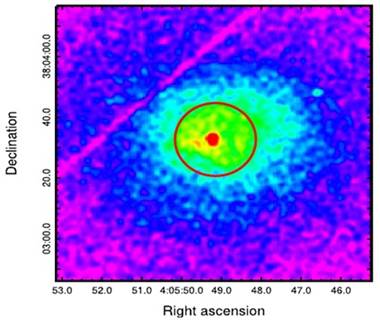Discovery of Iron Lines in X-rays from a Binary Black Hole System: A Breakthrough in Astronomy
Astronomers have discovered iron lines in X-rays from the well-known binary black hole system in the radio galaxy

Or login with email
Join our subscribers list to get the latest news, updates and special offers directly in your inbox

Astronomers have discovered iron lines in X-rays from the well-known binary black hole system in the radio galaxy 4C+37.11, located 750 million light-years from Earth. This breakthrough marks the first time such X-ray lines have been observed in a binary system, paving the way for a deeper understanding of the system’s properties and dynamics.
4C+37.11 is a binary active galactic nucleus (BAGN) containing two supermassive black holes (SMBHs). These SMBHs are separated by a mere 23 light-years and are located 750 million light-years from Earth.
Discovered in 2004, this system offers a rare and valuable opportunity to study dynamics and interactions in such extreme environments.

Image caption: Chandra X-ray image of the core of 4C+37.11. The red circle is the region considered for spectral analysis.
Dr. Shantanu Mondal, Ramanujan Fellow at IIA and the lead author of the study, stated:
"For the first time, we have identified ionized iron Fe K lines in 4C+37.11. This discovery can shed light on the properties of black holes and the processes associated with their mergers."
Dr. Mousumi Das, co-author of the study, added:
"Fe K emission lines are critical for estimating the mass and spin of black holes. They also help us understand the behavior of surrounding matter and radiation in extreme conditions."
The study involved contributions from researchers at the Indian Institute of Astrophysics, as well as scientists from Norway, the United States, and the University of New Mexico.
The findings have been published in the prestigious journal "Astronomy & Astrophysics."
This discovery not only advances the study of binary black hole systems but also opens new avenues in astrophysics. It provides insights into the generation of gravitational waves during black hole mergers and the changes in their surrounding environment.
This milestone achievement highlights the potential of X-ray observations to explore the mysteries of the universe’s most enigmatic objects.







prativad Feb 10, 2025
prativad Nov 18, 2024
Around the world, certain destinations are renowned for their unique lifestyle,...
Jackmark Nov 3, 2025
IV Drip Therapy in Abu Dhabi has emerged as a cornerstone of this wellness evolution,...
prativad Oct 1, 2024
California Governor Gavin Newsom has vetoed a major bill that aimed to introduce...
prativad Oct 27, 2025
India’s refiner Reliance has said it is assessing Western sanctions on its Russian...
prativad Oct 20, 2025
As the 80s and 90s began, Asrani successfully transitioned into far more mainstream...
prativad Feb 26, 2025
A new study conducted by Australia’s e-Safety Commission has revealed startling...
digicrome May 27, 2025
In today’s digital saving, data learning and artificial intelligence (AI) are as...
prativad Jan 11, 2025
Astronomers have discovered iron lines in X-rays from the well-known binary black...
news voir Mar 28, 2024
Anupam Kher, an internationally acclaimed Indian actor, best-selling author and...
prativad Sep 22, 2024
Renowned AI expert Julia McCoy has painted a stark picture of humanity's impending...
Breaking News | In-Depth Analysis | Real-Time Updates
Covering Everything You Care About – Politics, Business, World News, Entertainment, Sports, Health, Lifestyle, Education, and more — all in Hindi!
Stay informed. Stay empowered.
Visit Now www.prativad.com
PRATIVAD.COM – डिजिटल खबरों की सच्ची आवाज़!
